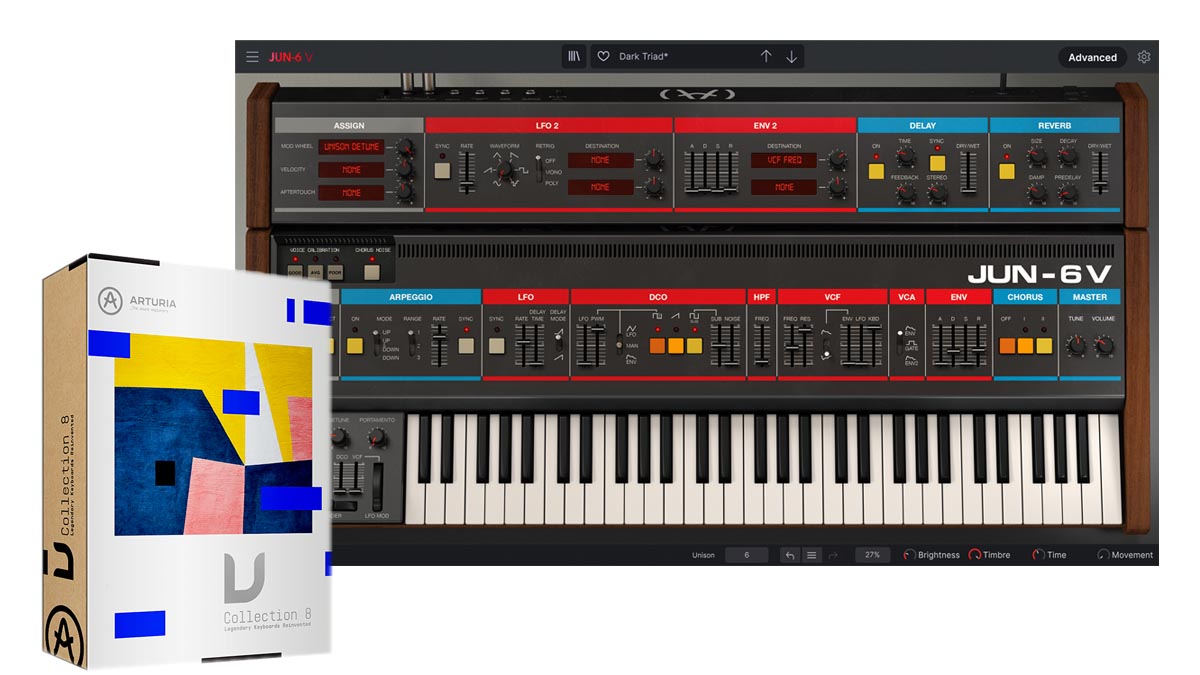MusicRadar Verdict
It’s certainly not a cheap bundle and can certainly be a bit daunting, but the latest incarnation of this classic package offers so much it’s impossible to ignore.
Pros
- +
Considerable cost saving over buying individual instruments.
- +
Vocoder V is one of the best vocoders we’ve used.
- +
Excellent new and updated Roland synths.
- +
Very useful and informative In-App tutorials.
- +
Extensive software-only enhancements.
- +
Great new macro feature and implementation.
Cons
- -
Choice can be overwhelming.
MusicRadar's got your back
What is it?
Arturia’s V Collection (VST, VST3, AU, AAX and standalone) is a mainstay of the VSTi world that has grown over the years to incorporate a combination of mainstream and rare synths, pianos, organs and string machines.
Of course, you can purchase the instruments individually, but the collection delivers a considerable financial saving and also includes their Analog Lab package, which is a preset-packed workstation that pulls together patches from all of the instruments.
Although the names are sometimes modified, Arturia’s V instruments are full-on emulations of original hardware synths and use their own component accurate analogue (TAE) and physical (Phi) modelling emulation technology. The highly accurate emulations are then enhanced with plenty of software-only extras.
V Collection 7 added some tidy new emulations based on classics such as the Casio CZ 101, EMS Synthi AKS and Mellotron. In contrast, V Collection 8’s additions are very mainstream instruments from Oberheim, Moog, E-mu and Roland. The recently released OB-Xa V is joined by three completely new emulations – Jun 6V, Emulator II V and Vocoder V.
Once again the sound library has been expanded and the PatchWorks bundle adds 700 contemporary presets. Across all instruments you now have over 10,000 presets, which is a staggering number
There are also two major updates in the form of Jup-8 V 4 and Stage-73 V 2. Once again the sound library has been expanded and the PatchWorks bundle adds 700 contemporary presets. Across all instruments, you now have over 10,000 presets, which is a staggering number.
The 27 classic instruments are ARP2600 V3, B-3 V2, Buchla Easel V, Clavinet V, CMI V, CS-80 V3, CZ V, DX7 V, Emulator II V, Farfisa V, Jun-6 V, Jup-8 V4, Matrix-12 V2, Mellotron V, Mini V3, Modular V3, OB-Xa V, Piano V2, Prophet V3, SEM V2, Solina V2, Stage-73 V2, Synclavier V, Synthi V, Vocoder V, Vox Continental V2 and Wurli V2.
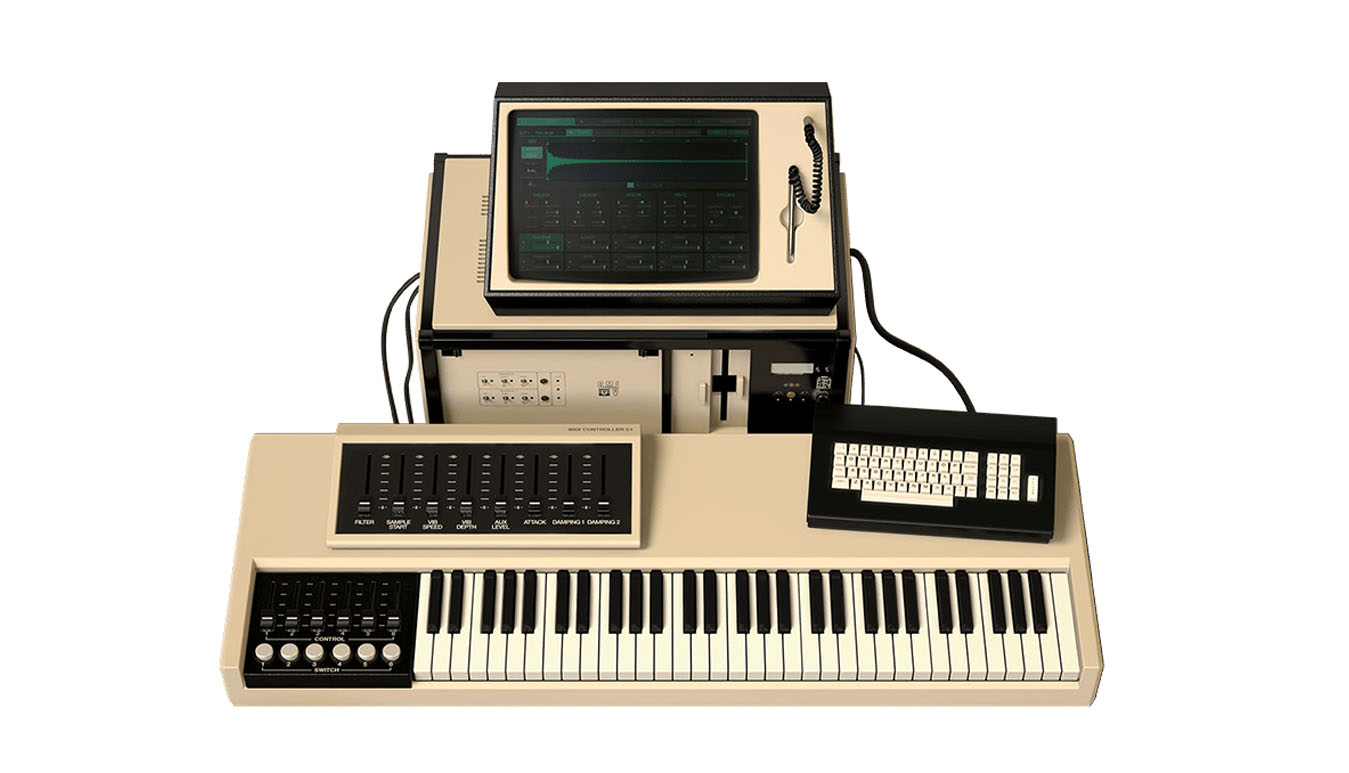
Refresh
To coincide with the release, all instruments have received a refresh. And whether you’re a new purchaser or existing user, Arturia’s Software Centre app handles the download, install and authorisation process.
Want all the hottest music and gear news, reviews, deals, features and more, direct to your inbox? Sign up here.
The refresh brings with it a new preset browser, streamlined in-app tutorials, and four Macro knobs in the bottom right of the plugin window. The Macro controls provide standardised broad brush editing across all instruments (Brightness, Timbre, Time and Movement), although note that the parameters they control vary.
All instruments now have a foldout side panel, which is accessed on the right-hand side using the gear icon. This panel has four tabs – Settings, MIDI, Macro and Tutorial.
The MIDI tab accesses MIDI CC mapping and incorporates parameter ranges as well as save and recall of specific mapping configurations. If you’re using an Arturia controller it’s also where you can specify which one. Macro provides access to settings for the four pre-assigned Macro controls.
As mentioned, these are standardised across all instruments, but the parameters controlled vary considerably and this is where you can edit them. Additional multiple target parameters can be added and the existing routings removed if you wish, and a handy multipoint curve lets you specify precisely how the macro behaves within its high and low limits.

Roland
Without question, V Collection 8’s hottest addition is Jun-6 V. Based on Roland’s ever-popular Juno-6 and Juno-60, these are synths whose simple architecture make them easy to program. Admittedly, the toy-like colour scheme and slider controls may not be to everyone’s taste, but the sound is killer.
Jun-6V does an excellent emulation job and a quick look at the presets reveals a bunch of numbered patches to match the original Juno-60 sound set. There are of course further presets (around 180 in total) and many of these take advantage of options not found on the original hardware.
Enhanced parameters are accessed via the Advanced panel and here you’ll find a second ADSR envelope, a second LFO, Delay and Reverb effects, and flexible mod wheel, velocity and aftertouch assignments. The second envelope and LFO are both far more flexible than the original ones. The LFO has six waveforms including sample-and-hold and both envelope and LFO have two assignable destinations with many parameter options.
If you like to use chord memories, Jun-6 V’s is accessed via the Chord Select button. This opens a floating window with a variety of handy voicing presets (octave, fifth, suspended and so on).
Finally, for analogue completeness, there are two further features. Voice Calibration emulates the subtle variations that can exist from voice to voice on a hardware Juno. The three options (good, average and poor) let you choose how much analogue drift is emulated. Chorus Noise adds audio hiss when the chorus is in use.
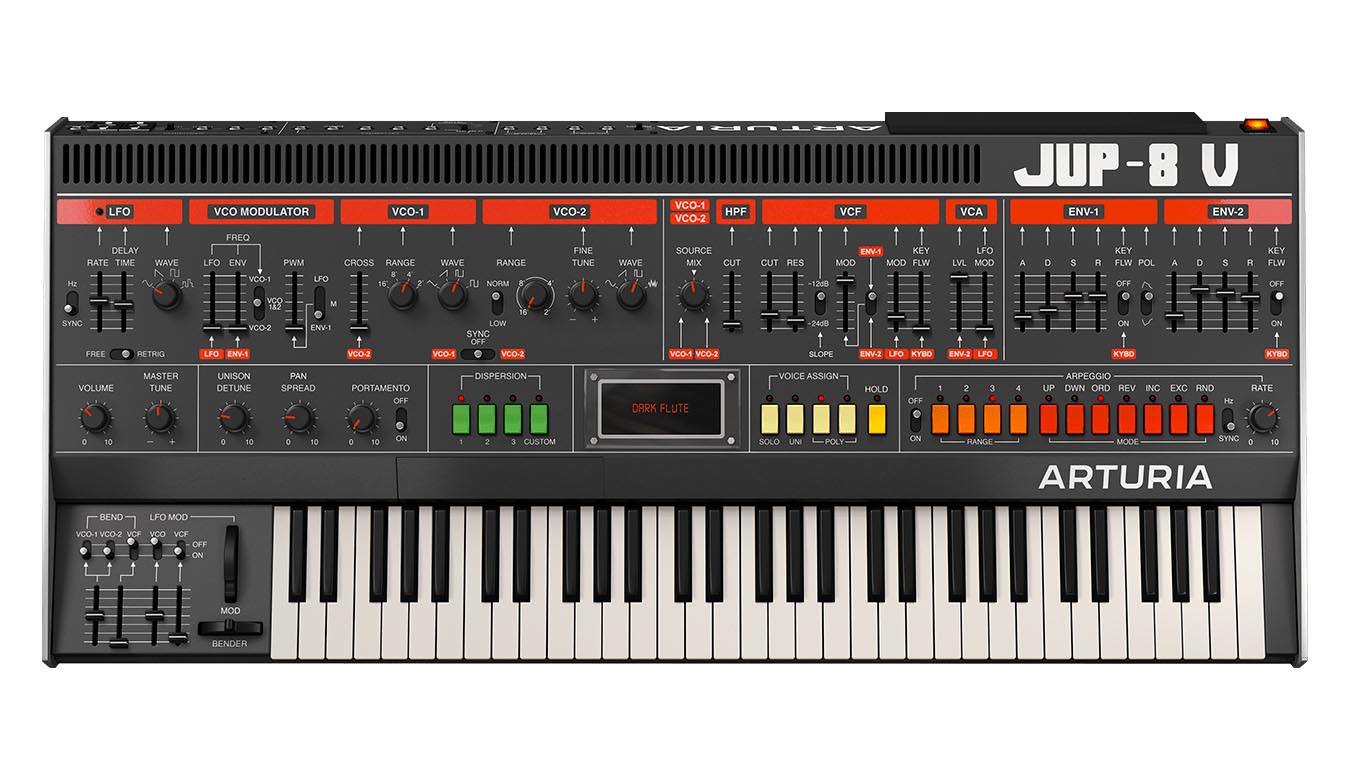
As you might expect, Jun-6 V delivers solid basses (Velo Bass and Under The Basement) and pads of various timbres (Poly Unison Pad is a particular favourite). It also has plenty of contemporary presets including the rave-ready Dark Triad, ethereal Voix Uno and arpeggiator based Dub Sensation. It’s an excellent emulation that really captures the essence of the original.
Also new in V Collection 8 is Jup-8 V4. Based on the Jupiter-8, this long-running Arturia instrument has been rebuilt from the ground up with a brand new sound engine. This includes more authentic filter emulations, as well as core engine enhancements such as Unison Detune and adjustable Voice Dispersion.
Throw in two additional complex LFOs, three effects and extensive keyboard response assignments using Velocity, Aftertouch, Mod Wheel and Keyboard Tracking and Jup-8 V4 can easily take you to new tonal pastures. However, our favourite enhancement is the integrated Sequencer.
This two-layer design provides both note and modulation sequencers and is great for creating specific note patterns or finessing evolving textures. Finally, it’s worth noting that one aspect has been removed from this update and that is the keyboard split option.
Vocoder V
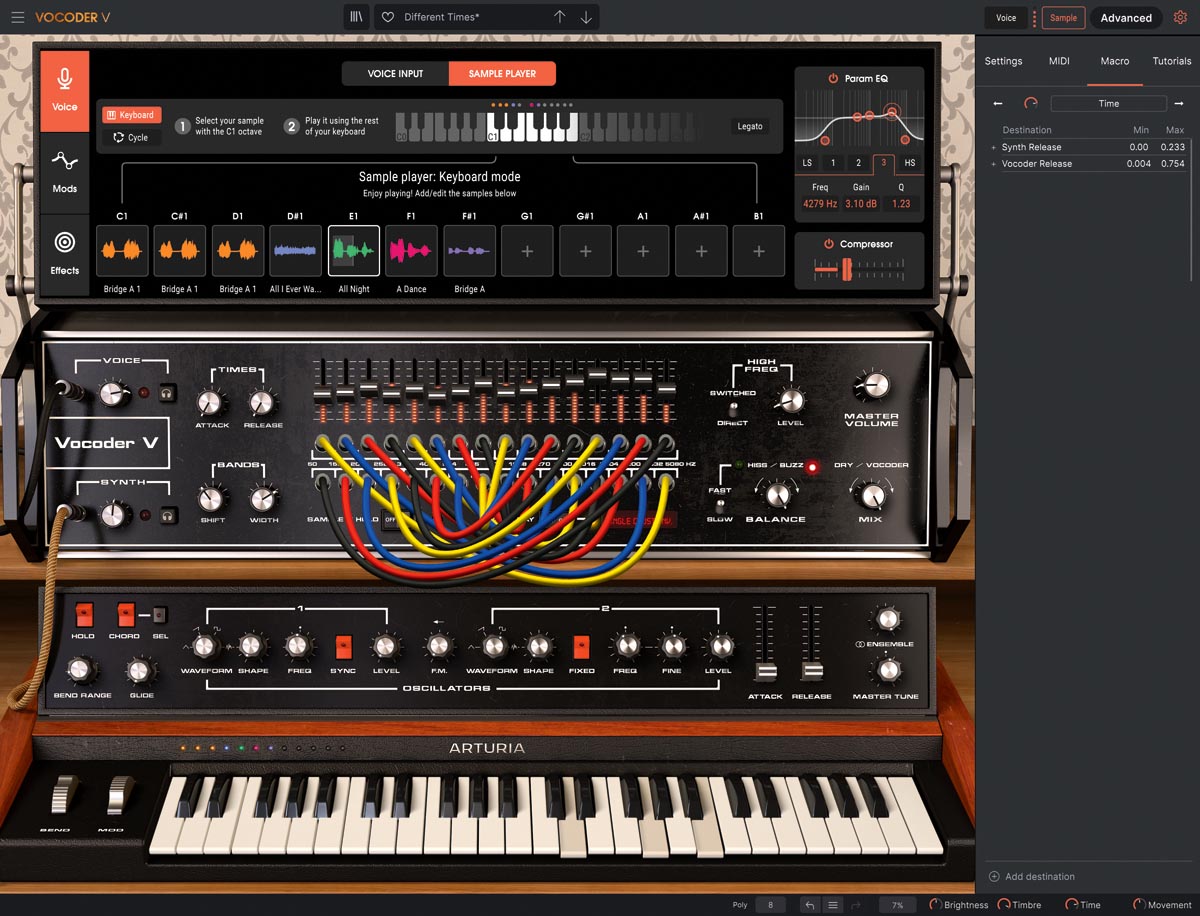
Software vocoders can be frustratingly disappointing and confusion surrounding how to implement the carrier and modulator signals is often partly to blame. Vocoder V is Arturia’s new Moog-inspired 16-band vocoder and it aims not only to capture the beauty of this classic effect but also to make the process of using it as rewarding as possible.
To that end Vocoder V is a voice analyser, synth and sampler all in one. What this means in practice is you can simply load it up and play it as an instrument, as each preset includes one or more samples from its accompanying library of over 700 samples. These act as modulators and the onboard two-oscillator synth handles carrier duties.
If you’d rather use your own modulator, you can route in audio from another track or an external DAW input. You’ll find instructions for your particular DAW in the Tutorials. You could also simply import your own samples. Vocoder V can handle up to 12 samples, includes keyswitch or cycled playback and even has real-time timestretch.
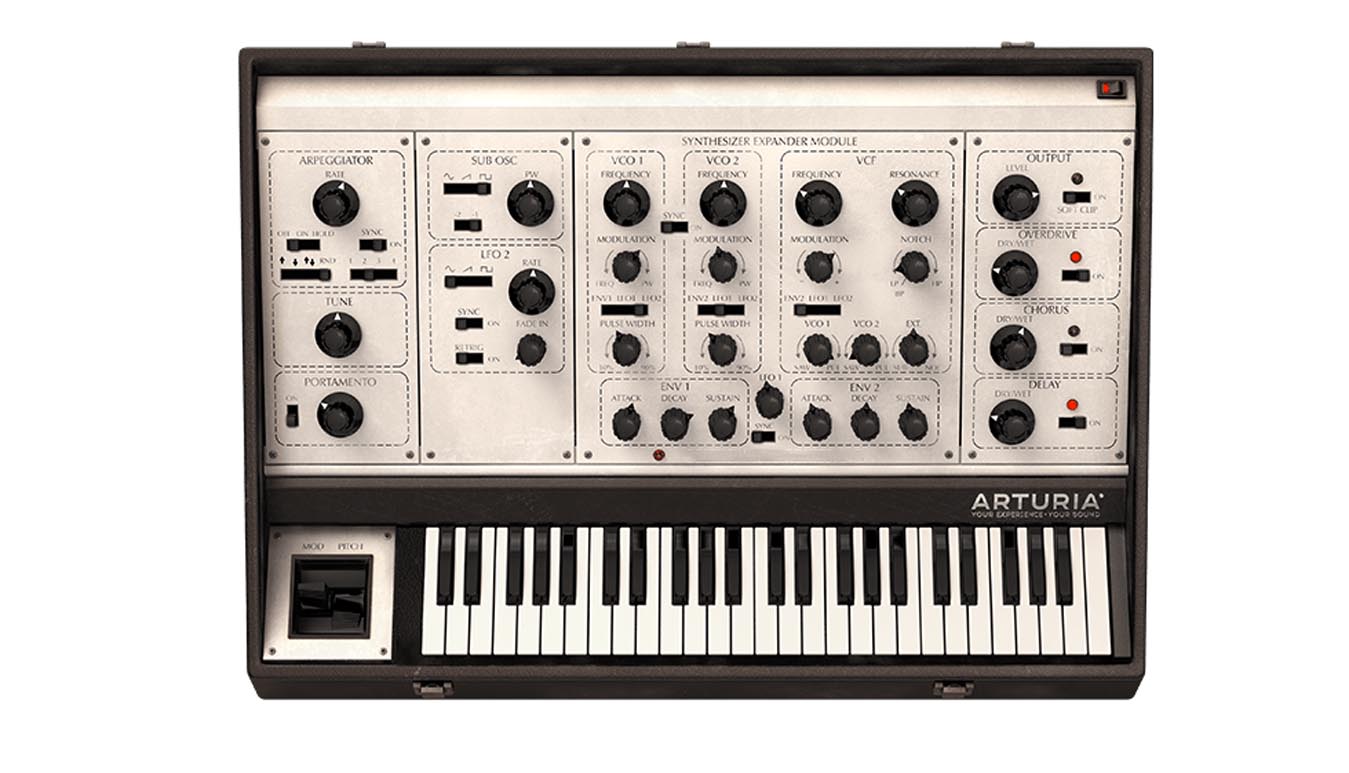
Vocoder V’s actual vocoder section includes modulator envelope shaping and a 16-band filter bank with global shift and global bandwidth settings. The carrier synth output can be carefully tailored using the band sliders, and there’s also a Patch Bay option.
This means you have much more control over how the modulator controls the carrier as you can cross patch bands. If you’re not feeling inspired there are five patching presets to get things rolling.
Rounding things off is an extensive modulation section with LFO and Envelope Follower and a three-module multi-effects section. With over 200 presets, getting started with Vocoder V is easy. The patches include excellent loop-based examples (Bright Future and House Butterfly are particularly good) and some good pads (Ghost In The Cabinet).
What’s more, the 100 or so vocal-based presets deliver classic vocoder effects into which you can easily substitute your own vocal audio should you wish. A great plugin that delivers classic sounds combined with contemporary functionality.
Emulator II V

E-mu’s Emulator II was hugely popular during the 1980s both for its sound and its included sample set. Now that we have pristine sampling at our fingertips, revisiting older sampling devices to capture their flavour is a great way to expand our sound palette and Emulator II V does just that.
It includes a collection of both classic and contemporary samples (over 300MB) spread across over 250 presets, and you can of course import your own samples as well. The reasonably straightforward keyboard interface gives way to a retro-inspired full window Screen option and this is where you edit the eight-voice sample engine.
Emulator II V has some great early drum samples with over 50 kits that include plenty of Roland classics. Modern sounds are also included and showcased by presets such as Lofi 808 Kit and Trap Hell Kit
Editing functions are spread across three tabs – Edit, Assign and Effects. In the Assign page you set key spans, velocity response and keyboard tracking. Meanwhile in the Effects page there are three rack effects. These include chorus, reverb and delay as well as parametric EQ and multimode filter, and the rack can be configured either in series or parallel.
Unsurprisingly most of the action happens in the Edit page, and here you can load and finesse your samples, choose loop points, adjust pitch and set play direction. Each sample voice gets its own insert effect and a choice of Modern or Vintage digital to analogue converters.
Meanwhile, global processing stages are lowpass filter and amplitude envelope. Emulator II V has some great early drum samples with over 50 kits that include plenty of Roland classics. Modern sounds are also included and showcased by presets such as Lofi 808 Kit and Trap Hell Kit.
Hard-hitting basses such as FM Operator are joined by some awesome sample-driven chord patches (Acoustic Wall). All told Emulator II V sounds great and is very easy to program.
Stage-73 V2
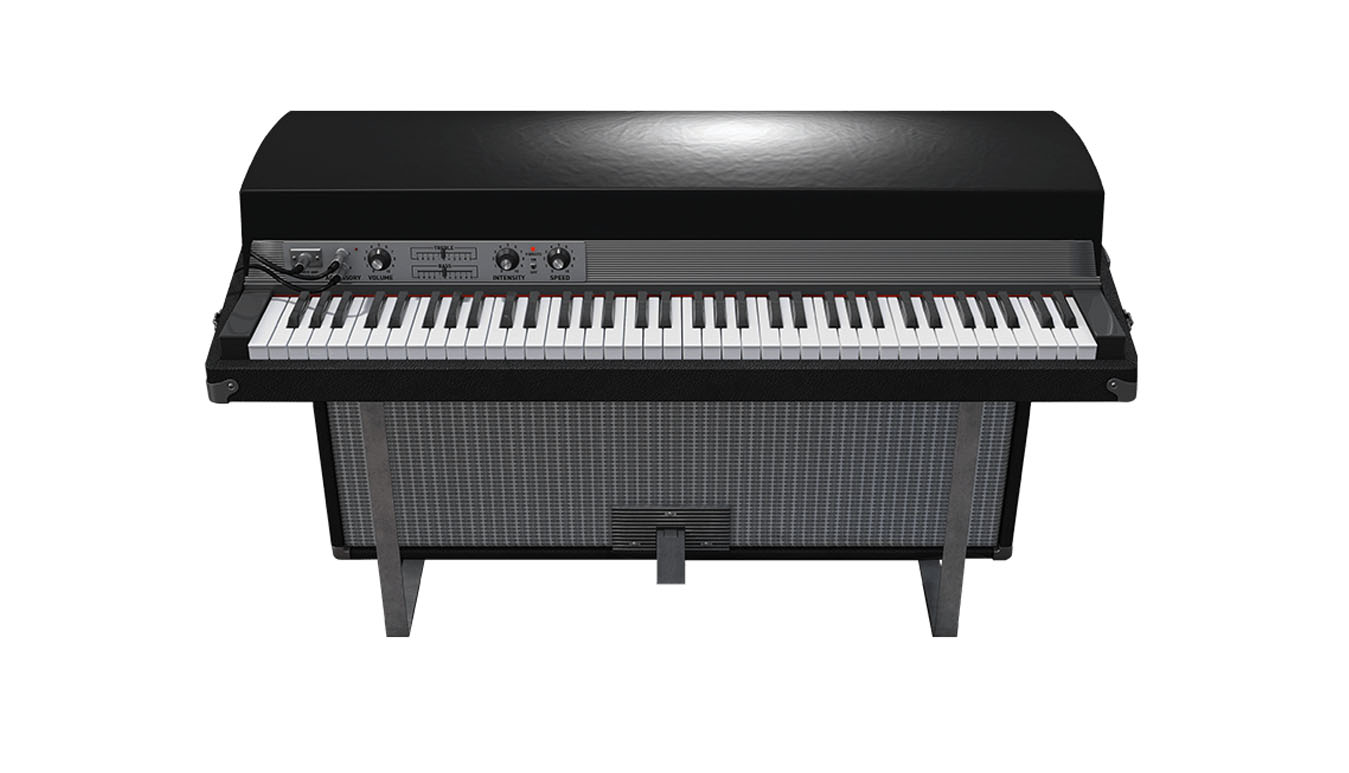
Basic electric piano instruments are pretty commonplace. More complex instruments that actually capture the feel and individuality of these amazing keyboards are harder to find, and Stage-73 V2 is clearly aiming for the latter.
Based on the classic Fender design it includes both Stage and Suitcase versions (the latter has additional treble, bass and vibrato controls), and the Stage option comes in two versions, ‘73 and‘74.
The core piano is then enhanced with a four-pedal FX rig, amp rig and reverb. The 13 pedal effects including Rhodes-friendly options such as analogue delay, auto-wah and analogue phaser. Meanwhile, the amp rig includes either a rotary speaker or classic twin reverb amp. The V2 update features a new engine, updated pedals and seven underlying model presets that emulate the tone of specific hardware versions.
Across all patches coupling the core instrument with pedal and amplifier effects means the patches not only play well but are polished and production ready
The model option is found in the Advanced settings panel, and it’s here that you can really tailor the sound. First up you have three audio output options (mono, stereo or room) along with hammer hardness. Three further sections – mechanics, noises and acoustics – provide an impressive array of parameters ranging from pickup distance to tonebar resonance.
It sounds complex but the results speak for themselves and we absolutely love the massive range of tones these advanced settings can deliver. This is all demonstrated admirably by the 65 presets. There are some excellent workhorse options such as Dark Funk Keys and 1972 Latin Fusion.
There are also some great phased patches (Sweet Dual Phased EP 2) and stereo spread options (Nice Panner). Across all patches coupling the core instrument with pedal and amplifier effects means the patches not only play well but are polished and production-ready.
Oberheim
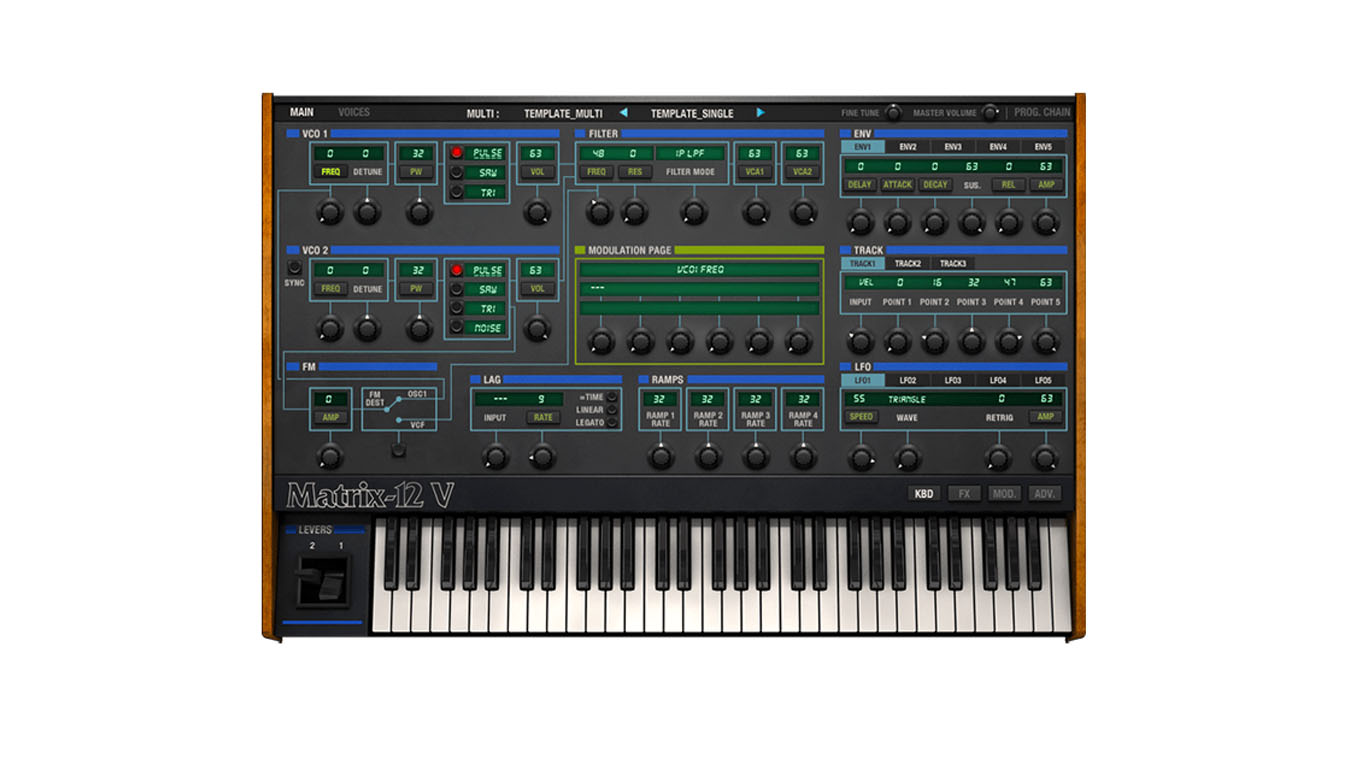
The OB series synths are well renowned and slightly quirky 1980s analogue synths. Arturia’s OB-Xa V was released a few months ago and has now been updated in line with the latest V Collection 8.
It’s primarily based on Oberheim’s OB-Xa, however, some aspects of other OB synths are included such as OB-X’s x-mod option whereby oscillator 2 controls oscillator 1. As you might expect OB-Xa V has many further software-only enhancements and features and one of the most significant is how it delivers stereo sounds.
The original hardware synth had internal tweakers to adjust the pan position of each of the eight voices. This is replicated in OB-Xa V’s Pan mode and when active a small panel with eight pan pots is available just above the lower keys.
As an alternative, Arturia has also added a Stereo mode. This duplicates the oscillators into two parallel paths and has an accompanying settings panel just above the mod wheel.
Parameters include relative oscillator tuning, left/right filter variation and LFO phase offset. There’s also an additional LFO that modulates the stereo position of each channel. To round things off, both options then go through the Stereo Spread control so you can tailor the final stereo width.
Overall these stereo settings can be anything from subtle to transformative and the Stereo mode, in particular, allows you to create impressive stereo width at the source.
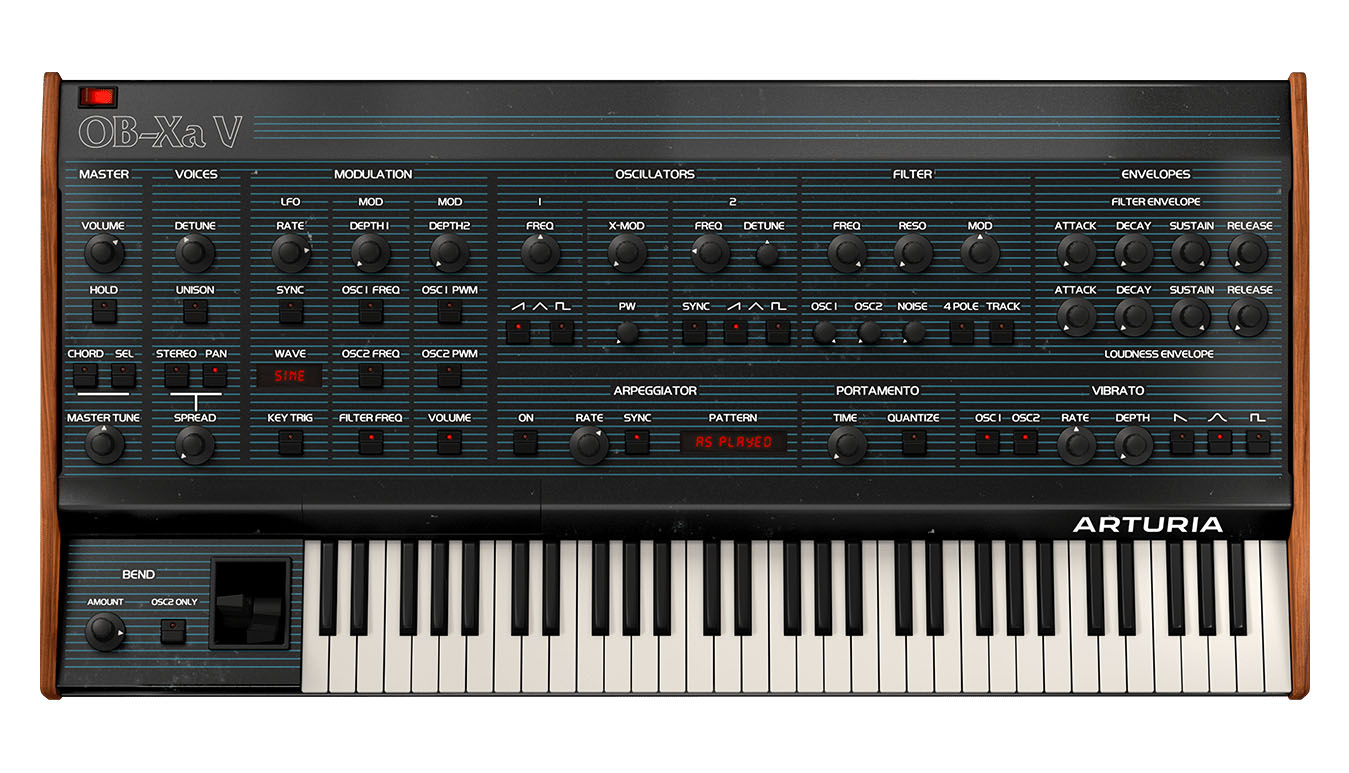
Further additional features include a syncable LFO with a choice of shapes and key retrigger, an arp, individual level controls for the two oscs and noise generator, and a pop-up chord memory window. Meanwhile the Advanced panel plays host to three effects modules and four function generators with user-definable curves with up to 16 breakpoints.
The original Oberheim OBs are rich-sounding polysynths capable of delivering aggressive bite that will cut through and OB-Xa V really delivers this. From punchy basses (Weight Squares) and earthshattering subs (Big Sub) to oodles of 80s-style ‘brass’ sounds, the presets cover a lot of ground.
The more contemporary sounds stand out (DNB Chord Lead for example) though we also like the many super-rich pads (C-3 Slow Strings) and textures (Moving Drone). There are also plenty of edgy – though not spiky – leads (Hard Lead), thick plucky sounds (Take Turn 19) and some cool chord memory patches (Chord Repeater).
Finally, it’s great that the presets are not bathed in effects when you load them, and also that if you do wind up an effects mix, the effect has been chosen to work with that patch.
Performance and verdict
In App Tutorials
Over the years Arturia has considerably refined the look and features of their instruments and when you compare some of the early examples like the Jupiter 8 with its latest Jup-8 V 4 incarnation the difference is striking. In-App tutorials are an enhancement feature that first appeared in V Collection 7 and these are now refined in 8.
Available from the new right-hand side panel, tutorials are divided into Learn The Instrument and Sound Design categories and once launched provide walkthrough-style text instruction in the panel below. As you work through, the pertinent aspects of the interface are highlighted and whether you’re just after a quick overview or explanation of deeper features, these provide a great way to learn how these classic synths and instruments work.
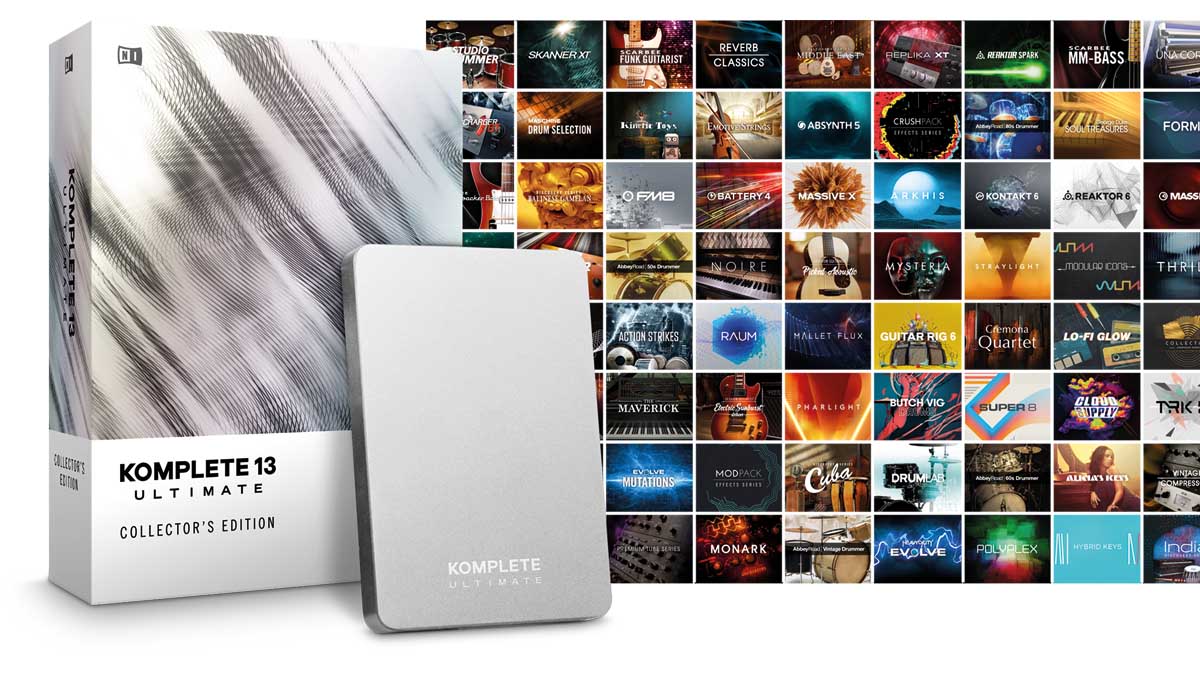
• Native Instruments Komplete Ultimate Collectors Edition
This ever-expanding bundle covers more ground and is always worth checking out.
• UVI Vintage Vault 3
With 65 instruments and over 10,000 presets, UVI’s sample-based package delivers an incredible selection of classic sounds.
• IK Multimedia SampleTank
It’s ‘only’ 260GB, but ST4 Max does deliver pretty much all the sounds you need for less outlay.
If you want to really get to grips with things, the Sound Design tutorials help you achieve certain sounds, and the interactive process is quick and intuitive. As an example, you’ll find three such tutorials for the CZ V including a rather nice pad sound (Noisy Pad).
This has more than 60 tutorial steps starting with oscillator choice and finishing with the effects section. Alas, not all instruments include Sound Design tutorials and this is certainly something we’d expect to see in future updates.
That said, the overall execution is great and it really is a more enjoyable learning experience than trawling through the manual.

It can be tricky assessing the strengths and weaknesses of a multifaceted bundle like V Collection. Still, it’s certainly proved itself over time (although in hindsight the earlier versions seem basic compared to what’s on offer now).
Overall, V Collection 8 clearly adds some gems and we really like Jun-6 V and Vocoder V. It’s also great to see their Jupiter 8 emulation getting a full-on rework. But for us what makes the new version a success is that the overall user experience is slicker than before.
Features like the Macros may seem small, but across all instruments, it creates a cohesiveness that wasn’t there before. This is Arturia’s best offering yet and as a vintage instruments bundle with a modern twist, it’s hard to beat.
MusicRadar verdict: It’s certainly not a cheap bundle and can certainly be a bit daunting, but the latest incarnation of this classic package offers so much it’s impossible to ignore.
The web says
”Ultimately, V Collection 8 is a remarkable collection and, at the current price of around £19 per instrument, it’s stunning value. Sure, there are niggles but, despite my critical faculties remaining fully functional, there are times when I just have to say ‘well done’.”
Sound on Sound
This collection is absolutely fantastic and not to be missed. It’s a fraction of the price point that you’ll see many competitors charging. It sounds great, takes up a wonderfully reasonable footprint on your SSD, and the instruments are stable and reliable.
Ask Audio
Hands-on demos
Venus Theory
Benn Jordan
Jef Gibbons
Arturia
Specifications
- TYPE: Software synth and keys bundle (VST, VST3, AU, AAX and standalone)
- KEY FEATURES: 28 software instruments including ARP2600 V3, B-3 V2, Buchla Easel V, Clavinet V, CMI V, CS-80 V3, CZ V, DX7 V, Emulator II V, Farfisa V, Jun-6 V, Jup-8 V4, Matrix-12 V2, Mellotron V, Mini V3, Modular V3, OB-Xa V, Piano V2, Prophet V3, SEM V2, Solina V2, Stage-73 V2, Synclavier V, Synthi V, Vocoder V, Vox Continental V2 and Wurli V2; expanded sound libraries with over 10,000 presets across all instruments.
- SPECIFICATIONS: Windows 8.1+ (64bit) PC: 4 GB RAM; 2.5 GHz CPU. 20GB free hard disk space OpenGL 2.0 compatible GPU || Apple: 10.13+: 4 GB RAM; 2.5 GHz CPU. 20GB free hard disk space OpenGL 2.0 compatible GPU
- CONTACT: Arturia
Computer Music magazine is the world’s best selling publication dedicated solely to making great music with your Mac or PC computer. Each issue it brings its lucky readers the best in cutting-edge tutorials, need-to-know, expert software reviews and even all the tools you actually need to make great music today, courtesy of our legendary CM Plugin Suite.
